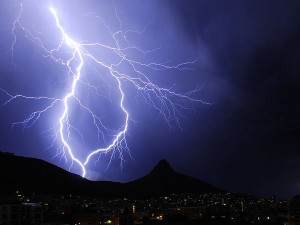 This months wilderness medicine club meeting discussed a great paper talking about lightning strikes. You can download the paper here:
This months wilderness medicine club meeting discussed a great paper talking about lightning strikes. You can download the paper here:
Zina was also nice enough to put together a fast summary of the highlights of this article. Here they are:
Wilderness Medical Society Guidelines for the Prevention and Treatment of Lightning Injuries.
Davis C, Engeln N, Johnson E, McIntosh S, et al. Wilderness & Environmental Medicine, 23, 260-269 (2012)
Background
– Thunderstorms are a result of moisture, warm air, and a lifting wind; as water condenses and freezes into particles on top of clouds, the movement of these particles forms an electical gradient that is discharged as lightning.
– Wordwide, central Africa has the greatest incidence of lightning strikes
– In the US, the northeast and south have the highest incidence, with rural populations being at greatest risk
– Approximately 400 lightning injuries occur every year, with about 10% of these resulting in death.
Mechanisms of Injury
– Lightning injuries are classified as: direct strike, contact injury, side splash, or ground current
– A fifth, recently reported mechanism is the “upward streamer”, when lighting passes through the ground without a nearby lightning strike
Prevention
– “When thunder roars, go indoors” – if you can hear thunder, there is a risk of lightning strikes and you should seek shelter immediately
– If far from the indoors, seek shelter inside a deep cave, far in a dense forest, or in a deep ravine; staying in an open, exposed area puts you at highest risk
– Avoid shallow caves, solitary trees, and open shelters (such as dugouts and lean-to’s) because of the risk of side-splash.
– If lightning strike is imminent and you’re indoors, take the “lighting position”
- Sit or crouch with knees and feet close together to create only one point of contact with the ground
- Try to insulate yourself from the ground – sit on a pack (after removing metal), dry coiled rope, or rolled foam sleeping pad
– If in a group, separate from each other by at least 20 feet
Triage and Resuscitation
– Reverse triage: Lightning strike victims classically suffer initial asystolic arrest caused by simultaneous depolarization of all myocardial cells; Ventricular fibrillation can also occur.
– Victims of lightning strike do not carry residual electrical charge – it’s safe to resuscitate them!
– Have high suspicion for injury and low threshold for admission in high risk patients:
Complications
– Neurological: Keraunoparalysis – transient paralysis after lightning strike, typically resolves within several hours
– Derm: “Lichtenberg figure”
– Eyes: Cataracts can form, often over several days
– ENT: Eardrum rupture
– Psychiatric, neurocognitive complications may develop weeks to months afterwards
– Pregnant patients do not have higher mortality but fetal mortality is 50%, due to being surrounded by highly conductive amniotic fluid
Mark Silverberg
Latest posts by Mark Silverberg (see all)
- Brown Recluse Spider Bites - July 17, 2015
- Avalanche! - June 6, 2015
- Concussion Management in the Wilderness - May 12, 2015
- Inflight Medical Emergencies - January 13, 2015
- - December 24, 2014
